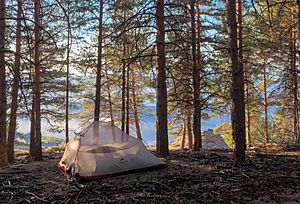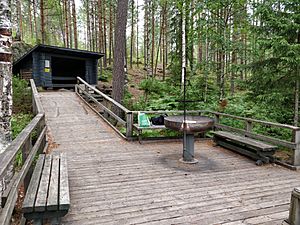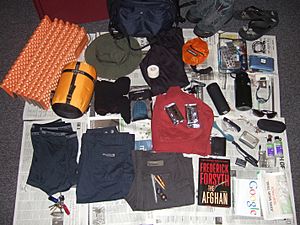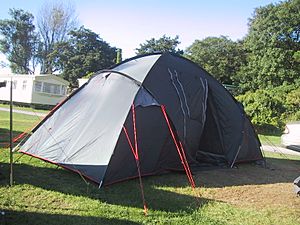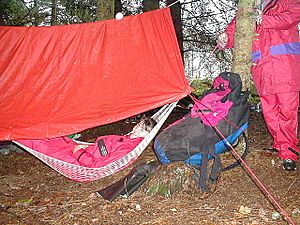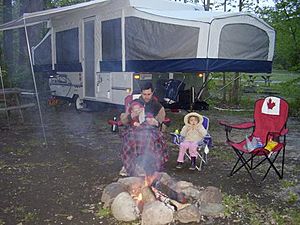Camping facts for kids
Camping is a fun outdoor activity where people stay overnight in a temporary shelter. This shelter is often a tent, but it can also be a recreational vehicle (RV), a special permanent tent, or even a simple bivy or tarp. When you go camping, you usually leave busy towns and cities to spend time in nature. People go camping to enjoy outdoor activities, learn new skills, or just relax. Staying overnight is what makes camping different from a day trip or a picnic.
Camping became popular with some wealthy people in the early 1900s. Over time, it became popular with many different kinds of people. Today, campers often visit public natural places like national parks, state parks, and wilderness areas. Some countries, like Sweden and Scotland, even allow camping on private land. Camping is also a big part of youth groups like Scouting. It teaches kids how to be self-reliant and work well in a team.
Contents
What is Camping?
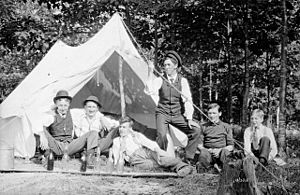
Camping means staying and sleeping outdoors for one or more days. You usually sleep in a tent.
Camping includes many different ways to stay outside. Some campers, called survivalists or wild campers, try to bring as little as possible. They want to see if they can get by with just the basics. Other campers bring lots of special gear for comfort. This can include their own power, heat, and even camping furniture.
Camping often goes hand-in-hand with other outdoor fun. You might combine it with hiking (called backpacking), canoeing, kayaking, climbing, fishing, or hunting. Fastpacking is a mix of running and camping.
It's important to know that not every outdoor stay is "camping." For example, a children's summer camp with cabins and dining halls is different. And a homeless person living outdoors is not "camping." Camping is usually a choice people make to enjoy nature and feel refreshed.
The History of Camping
Many people say that recreational camping started with Thomas Hiram Holding. He was a British tailor who loved to travel. But camping was actually popular in the UK on the river Thames even before him. By the 1880s, many people were camping as part of pleasure boating.
Thomas Hiram Holding helped make a different kind of camping popular in the early 1900s. He had camped a lot as a child, traveling across the American prairies with his parents. Later, he went on a cycling and camping trip in Ireland with friends. He wrote a book about this trip called Cycle and Camp in Connemara. This book led to the first camping group in 1901, called the Association of Cycle Campers. This group later became the Camping and Caravanning Club. In 1908, he wrote The Campers Handbook to share his love for the outdoors.
One of the first places to offer commercial camping was Cunningham's camp in the Isle of Man. It opened in 1894. In 1906, the Association of Cycle Campers opened its first camping site in Weybridge. By 1910, the group had hundreds of members. After the First World War, camping became even more popular. Sir Robert Baden-Powell, who started the Boy Scouts movement, became the club's president in 1919.
In the United States, camping became popular after a book called Camp-Life in the Adirondacks was published in 1869. This book brought many visitors to the Adirondacks.
In the early 1900s, famous Americans like Henry Ford, Thomas Edison, John Burroughs, and Harvey S. Firestone also made camping popular. They were known as "The Vagabonds." They traveled to different states for ten years, and their trips were often in the news. They would drive to places like the Adirondacks and live off the land, buying food from farms.
The International Federation of Camping Clubs started in 1932. By the 1960s, camping was a common family holiday. Today, you can find campsites all over Europe and North America.
Different Types of Camping
Camping can be named after how you travel to your campsite. This includes canoe camping, car camping, RVing, and backpacking. Backpacking can also be ultralight backpacking, where you carry very little gear.
Camping can also be described by the style of your trip:
- Glamping (glamorous camping) mixes camping with the comforts of a home or hotel. It started in the early 1900s with European and American safaris in Africa.
- Workamping is when campers work in exchange for discounts on campsite fees, utilities, or even some pay.
- Migrant camps are temporary homes for workers, not for fun.
- Some campgrounds for custom harvesters in the US have space for large farm equipment.
- Camping is also popular at air shows, like the Oshkosh air show. People often camp in small tents under their aircraft's wing.
Camping Gear You Might Need
The gear you need for camping depends on what you plan to do. For example, if you are survival camping, you'll need small, light items. These items help you find food, stay warm, and be safe. They must be easy to carry.
Winter camping needs special gear. You'll need strong tents and warm clothing to protect you from wind and cold.
Survival camping also involves a small kit of important items. These are things you should always carry on you, not just in your backpack. This kit might include:
- A small metal container to heat water over a campfire.
- A small piece of duct tape for quick fixes.
- An emergency space blanket. These blankets are small, light, and great for making shelters or staying warm. They are also reflective, so they can be seen from an aircraft.
- Candle stubs for starting fires and warming small spaces.
- One or two band-aids for small cuts.
- Waterproof matches or a lighter.
- A large safety pin or fish hook for fishing.
- Rubber gloves, antiseptic wipes, tinfoil, a jackknife, or halazone tablets (to clean water).
Even though this sounds like a lot, these items are small and light. They can be very helpful in an emergency!
Common Camping Equipment List
Here is a list of common things campers use:
- First aid kit
- Tent, lean-to, or other shelter
- Hammer or mallet to put tent stakes in the ground
- Sleeping bag and/or blankets to stay warm
- Sleeping pad or air mattress for comfort and insulation from the cold ground
- Lantern or flashlight
- Hatchet, axe, or saw for cutting firewood
- Fire starter to light a campfire
- Folding chairs to sit around the campfire
- Ropes for clotheslines or securing your shelter
- Tarp for extra rain protection or to cover a dining area
- Raincoat or poncho
- Hiking boots
- Fishing pole
- Canteen (bottle) for water
- Chuck box to hold kitchen items for cooking and cleaning
- Trash bags to pack out your waste (important for "leave no trace")
- Cathole trowel for bathroom needs where there's no toilet
- Insect repellent
- Sunscreen
- Personal care products and a towel
- Cooler for food and drinks. If you have electricity, you can use a special electric cooler.
- Bottled water or a portable water filter if you're near rivers or lakes
- Cooking tools like a grill, Dutch oven, or clay pot for cooking over a campfire. A portable stove is good if campfires are not allowed.
- Firewood for campfires
- Emergency Preparedness Kit
- Multi-Tool or knife
- Global Positioning System (GPS)
Many items you need for camping might already be at home, like dishes and pots. But some people buy special camping gear that is tougher or lighter. Backpackers, for example, use very lightweight gear.
Campgrounds and Campsites
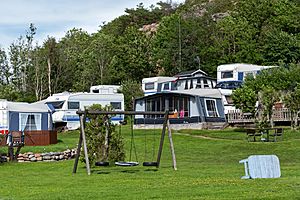
Campers come in all ages and abilities, and campsites are designed in many ways. Many campgrounds have sites with fire rings, barbecue grills, and shared bathrooms. Some even have laundry facilities and access to fun activities. But not all campsites are the same. They can range from a simple patch of dirt to a paved spot with water, sewer, and electricity hookups. Many campgrounds also offer cabins.
People use different vehicles for camping, like motorcycles, bicycles, boats, canoes, or even small planes. But backpacking (camping on foot) is also very popular.
Tent camping sites usually cost less than sites with all the hookups. Most allow you to drive right up to your tent. Some "walk-in" sites are a short walk from the road and don't need full backpacking gear. People who want a rugged outdoor experience often camp with just tents, or even sleep "under the stars" with no shelter at all.
How Popular is Camping?
Camping is very popular around the world!
In the United States
Camping is growing in popularity in the United States. Millions of people go camping each year.
In the United Kingdom
In the first half of 2015, almost 4.5 million camping and caravanning holidays were taken by people living in Britain. This was an 8% increase from the year before! The Caravan Club and the Camping and Caravanning Club are big groups for campers in the UK.
Scotland has a special rule called "wild camping." This means you can camp on most open land, even if it's privately owned.
In France
In 2015, about 113 million nights were spent at French campsites. This was a 3.9% increase from 2014. Most of these campers were French, but many were also from the Netherlands, Germany, and the UK. The most popular area for camping in France is Languedoc and Roussillon.
In Canada
Canada has four seasons, and with the right gear, you can camp there all year round! In the late 1800s, Canada started setting up areas that later became National Parks. These parks are now some of the most popular places to camp.
Before the 1910s, camping in Canada was mostly for men. The first camping ground in a Canadian National Park was set up in 1964 at Lake Louise.
A study in 2016 showed that about 20% of people in Québec, Canada, went camping. That's about 1.6 million people! About 34% of campers in Québec camp in National Parks or Provincial Parks. Camping is popular not just for Canadians, but for travelers too.
Camping on Public Land
In a few countries, like Sweden and Scotland, you can camp on open land even if it's privately owned. This is called "public access." In Sweden, this right is part of their constitution. However, large groups usually need to ask the landowner for permission. In Scotland, you can camp on most open land, whether it's owned by the state or a private person. But you must always follow a "leave-no-trace" rule. This means you should leave the area exactly as you found it, taking all your trash with you.
See also
 In Spanish: Acampada para niños
In Spanish: Acampada para niños


